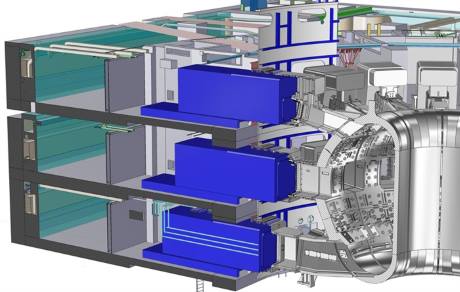Consortium secures record fusion robotics deal
28 October 2016
An earlier version of this story incorrectly referred to the members of the consortium as companies of the Vinci Group. Nuvia and Cegelec CEM are part of the Vinci Group, while Airbus Safran Launchers is a joint venture between Airbus Group and Safran Group.
A consortium of Airbus Safran Launchers, Nuvia and Cegelec CEM is to develop a remote handling system for the Iter project under the largest fusion energy robotics contract ever awarded, Fusion for Energy (F4E) has announced.
 |
| Cut-away image of the Iter machine showing the CPRHS casks (blue) inside the multi-level building (Image: F4E) |
The framework contract is worth nearly €100 million ($109 million) and will be implemented over a period of seven years. It covers the design, procurement, manufacture, delivery, installation, testing, commissioning and acceptance of Iter's Cask and Plug Remote Handling System (CPRHS). Franco-German company Airbus Safran Launchers will head the consortium as lead contractor, with partners Nuvia of the UK and Cegelec CEM of France. The UK Atomic Energy Authority, Portugal's Instituto Superior Tecnico, AVT Europe of Belgium and Millennium of France will also be part of the consortium.
The remote handling system will support the maintenance and repair of the Iter fusion machine, transporting irradiated components from the reactor's vacuum vessel - where space is very limited and human intervention is prohibited because of radioactivity - to the Hot Cell building for maintenance. The system will also be used to deliver remote handling equipment into the vacuum vessel.The multi-level reactor and maintenance buildings are connected by a service lift.
European Parliament renews Iter support
The European Parliament yesterday gave its final approval of F4E's accounts for fiscal 2014. financial year of 2014, formally signifying its ongoing support of the project. The parliament had postponed discharging the accounts in April pending a revised schedule and cost estimate of the Iter project. In June, the Iter Council - representing the seven Iter parties - endorsed an updated integrated schedule for the project identifying the date of first plasma as December 2025.
The CPRHS will use about 15 double-door transport casks which will provide primary containment during the transportation of the irradiated components. Resembling a slightly larger version of a standard shipping container, a fully loaded cask can weigh up to 100 tonnes and will need to be self-powered, remotely controlled with a positional accuracy of millimetres, and self-recoverable in the event of a failure.
The system will be underpinned by technologies including various high-tech skills, and must comply with nuclear safety requirements. Proven manufacturing experience in similar fields and the development of bespoke systems to perform mechanical transfers is therefore essential, F4E said.
The consortium combines the space expertise of Airbus Safran Launchers, Nuvia's experience in project management dating back to the beginnings of the UK nuclear industry, and Cegelec CEM as a specialist in mechanical projects.
As consortium leader, Airbus Safran Launchers is tasked with the industrial coordination of the CPRHS. "Space is an extreme environment in which no human intervention or repair work is conceivable, and we took our space know-how, developed on the Ariane launchers and the fully-automated European ATV space cargo, and adapted it for the remote-handling project of Iter. We are pleased to see that our know-how in complex projects is being recognized," Christine Francillon, head of complex systems and infrastructure programs at Airbus Safran Launchers, said.
Nuvia will bring to the project its international project management, engineering and services capabilities, supported by cross-discipline experience. CEO Keith Collett said the company was pleased to be playing a key role in "this important global objective".
Cegelec CEM, through its Cegelec CEM Nucléaire business group, provides engineering, design, manufacture and integration of equipment in the nuclear field and has a unique skill set in the development of mechanical and multi-expertise equipment. The company's areas of expertise include the design and manufacture of remote-operated tools, the design and supply of special equipment and processes, and maintenance work in limited access areas. "Iter offers our company a unique opportunity to demonstrate its ability to develop and build bespoke remote-handling equipment for a nuclear application in such complex context. Working with Airbus Safran Launchers and Nuvia will generate considerable added value, in which we are particularly proud to be part of," CEM Nucléaire sales director, Pascal Champ, said.
F4E is the European Union organization responsible for Europe's contribution to the international Iter collaboration alongside China, Japan, India, Russia, South Korea and the USA. The world's largest experimental nuclear fusion facility is under construction at Cadarache in the south of France. Nuvia and Cegelec CEM are companies of the Vinci group. Airbus Safran Launchers is a joint venture between Airbus Group and Safran Group.
Researched and written
by World Nuclear News